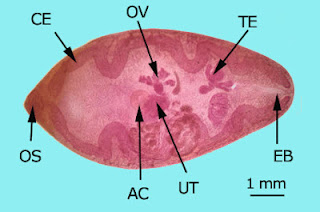 |
| Paragonimus westermani egg/CDC |
- There are numerous species in the genus Paragonimus that are found worldwide; primarily in Asia, but also Africa (P.africanus and P. uterobilteralis) and South America (P. peruvianus)
- P. kellicotti is found in North America
- Paragonimus westermani (most common)is also known as the "Oriental Lung Fluke".
Geography
- Found throughout Asia
- China is the major endemic area with 20 million people infected
- Also seen with low prevalence in Japan, Korea, the Philippines, Thailand
Morphology (adults)
- Large, plump flukes
- 7-16 mm length x 4-8 mm width x up to 5 mm thick
- Found in pairs in the lungs; looks like coffee beans
Morphology (eggs)
- Large, thick-shelled
- large, flattened operculum
- 80-120 um x 50-65 um
Life Cycle
- Unembryonated eggs passed into lung tissue and excreted in sputum; or swallowed and excreted in the feces
- Eggs embryonate in the water and miracidia emerge from egg and search for specific species of snail (first intermediate host)
- In the snail, miracidia goes transforms-sporocyst> rediae> cercariae
- Cercariae leaves snail and invades second intermediate host, a crustacean, typically a crab or crayfish
- The cercariae encysts into metacercariae (infective stage for human or animal host)
- Human infected after eating inadequately cooked crustacean
- Metacercariae excysts in small intestine and penetrates the gut wall
- Peritoneal cavity> abdominal wall> diaphragm> lungs
- Develop into adults in the lungs
- Prepatent period is 2-3 months
- Infection can last for years to decades
Pathology
- Migration of young worms (acute)may produce diarrhea and abdominal pain
- When established in the lungs: Fever, cough, rusty-brown sputum, hemoptysis (often thought to be tuberculosis at first)
- Migration of worms to other organs(erratic paragonimiasis) can be very severe, particularly when brain is involved
Diagnosis
- The presence of eggs in sputum or stool.
- Serodiagnosis
Treatment
- Praziquantel is the drug of choice
- Bithionol is alternate treatment
Epidemiology
- Humans or other mammals are definitive host
- Humans get infected eating undercooked crabs or crayfish
- China- "Drunken crabs" soaked in rice wine
- Philippines- roast crabs
- Thailand- raw crayfish salad
- Korea- soak crab in soy sauce
- Use of crab juice for seasoning and medicinal purposes
- Africa- undercooked crabs for fertility
- Pickled crabs
Prevention

No comments:
Post a Comment